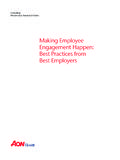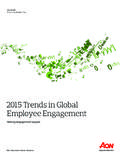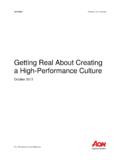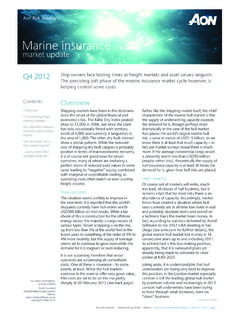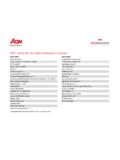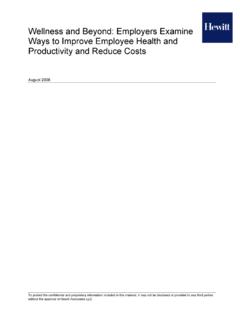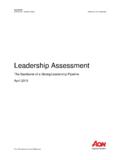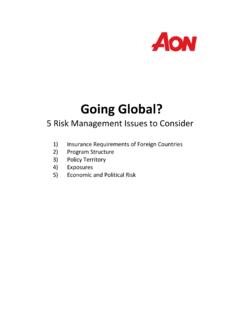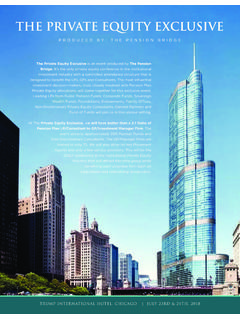Transcription of The Last Frontier - Health | Aon
1 Risk. Reinsurance. Human Last FrontierMyanmar s Insurance MarketApril 2017 Aon InpointAon Inpoint The Last Frontier : Myanmar s Insurance market 2 Introduction ..3 Myanmar presents significant potential for foreign investors due to its nascent market and need for adequate infrastructure ..4 The insurance market is slowly opening after a half-century of state monopoly ..5 Over US$2b insurance premiums by 2030? ..6 Many open questions and challenges for foreign insurers ..7 Contacts ..8 Table of ContentsAon Inpoint The Last Frontier : Myanmar s Insurance market 3 IntroductionMany insurance companies are looking for new markets to achieve profitable growth. This Aon Inpoint White Paper attempts a high level assessment of the potential of insurance in Myanmar. Under a democratically elected leadership, Myanmar has embarked on a journey of progressing reforms, as well as moves towards a more stable domestic socio-political environment, rapid economic growth and further integration into the global economy.
2 Despite these positive macro trends, the insurance market however remains de facto closed for foreign insurers and even domestic players are constrained by the prevailing regulatory framework. 2017 might be the year we see increased opening and liberalization, and this report provides some insights into the historical background and current situation of Myanmar s non-life and life insurance, and tries to identify areas of possible opportunity, where foreign insurers will be able to leverage their global capabilities, once they will have gained access to the market . Aon Inpoint s Asia team led by Andreas Balemi is happy to engage with you to discuss the opportunities and challenges that the opening of Myanmar s insurance sector will bring to global players wanting to find a footing in Asia s last Frontier ,Michael R. MoranChief Executive Officer Aon rate 2016 population55 MGDP per capita growth rate at constant prices8%USD60bnUSD1,406 GDPAon Inpoint The Last Frontier : Myanmar s Insurance market 4 Myanmar presents significant potential for foreign investors due to its nascent market and need for adequate infrastructureMyanmar stands as Asia s last remaining economic Frontier , since the government ended the country s decades-long isolation by adopting measures aiming at a more open economy and a more democratic society, which finally resulted in the lifting of international sanctions in late 55m habitants, equivalent to about 8% of Southeast Asia s total population, and a population growth rate of between 2005 and 2015, the foundations for an attractive market are definitely given.
3 Especially if we consider that 55% of the population is under the age of 30, while only 5% of people are aged above 65 years old1. The country is still predominantly rural, with 70% of its workforce employed in agriculture, and 38% of GDP coming from it. With industry and services accounting respectively for 22% and 40% of GDP, there is clearly room for development, which could raise disposable incomes and thus drive the emergence of a dynamic consumer society. Myanmar s GDP has been growing at circa 8% per year since 2012 (est. in 2016 vs for Asia overall) and today GDP per capita stands at US$1,406 (regionally the second lowest after Cambodia)2. While conditions for a success story are in place, the overall fragility of the economy could become a fundamental obstacle to rapid growth. Investments are particularly required to address the country s lack of basic infrastructure.
4 For instance, the transportation network needs important upgrades to cope with the rapid increase of vehicles (five fold since 2005), 1 World Bank2 Asian Development Bankand two thirds of the population is still living without electricity3. We anticipate power and road infrastructure projects are therefore likely to be the government s focus for the upgrades will not only directly support economic production, but also lift the country s attractiveness for foreign firms as a now accessible manufacturing basis for re-export and an expanding domestic the former international sanctions regime, Myanmar had in fact seen a degree of Foreign Direct Investment (FDI) over the past two decades, with two thirds of a total of $60bn flowing into oil & gas and power, while manufacturing and transport captured 10% and 8% respectively4. Neighbouring countries have historically been the main source of this FDI, with China contributing 28%, followed by Singapore (21%), and Thailand (16%)5.
5 Similarly, Asian contractors Chinese, Korean, and Japanese are being involved in large infrastructure projects, the construction of the Yangon Expressway (US$620m), and the Hanthawaddy airport (US$ )6. These mainly Asian investment inflows have played a vital role in building out much needed infrastructure and communication networks, and with Myanmar s progressive integration with the global business world, the country is indeed attracting increasing interest from outside Asia, as the US, Canada, and eight European countries have already started investing World Bank, World Development Indicators4 IEA, World Energy Outlook 20165 PwC report Doing Business in Myanmar, 20166 Myanmar Times0$500$1,000$1,500$2,000$2,500 CambodiaMyanmarLaosVietnam$2,106$1,767$1 ,406$1,124 GDP per capita (2016)Myanmar quality of infrastructure, rank among 148 countries surveyed (2014)Source: World BankSource: International Trade Centre (Intracen) populationwithout electricityMyanmarAon Inpoint The Last Frontier .
6 Myanmar s Insurance market 5 The insurance market is slowly opening after a half-century of state monopolyBetween 1963 and 2013, state-owned Myanma Insurance was the sole life and non-life insurer operating in the country through a network of around forty branches. Its monopoly was broken with the granting of 12 new licenses to privately-owned, domestic operators, nine of which are composite and active both in P&C and Life. Myanma has retained a leading role though, managing an insurance pool which absorbs all premiums above a certain threshold, and all insurers are obliged to offer the same products and follow the official pricing. Compulsory products, such as Motor Third Party Liability, dominate the market , which remains mostly concentrated in the main urban centre of Yangon. First signs of an opening to global insurers occurred in 2014, when three Japanese carriers1 were authorised to underwrite policies in the Thilawa Special Economic Zone (SEZ) around Yangon, targeting Japanese companies investing in Myanmar.
7 Twenty foreign insurers many of the world s leading players in the industry - and three global brokers have opened representative offices in Myanmar since the mid-90s, however their expectations have so far been frustrated by the slow pace of change, and they are still waiting for their operating licenses to be granted. There are signs indicating that 2017 will potentially see local players freed from existing restrictions, and the market increasingly open to foreign insurers, with the consequent influx of highly needed expertise, product innovation and underwriting capacity, as well as competitive pressures beneficial to the industry s Sompo Japan, Tokio Marine and MSIGG radual liberalization of Myanmar s insurance marketNon-life market GWP scenarios by 2030 (USD)ConservativeOptimisticBaseSource: Aon 29 28 27 26 25 24 23 22 21 20 19 18 172016 market penetration (% of GDP) market GWP scenarios by 2030 (USD)ConservativeOptimisticBaseSource: Aon 29 28 27 26 25 24 23 22 21 20 19 18 172016 market penetration (% of GDP) Japanese insurers inSpecial Economic ZoneForeign insurers allowedto penetrate the market ?
8 12 licences to privatelocal insurersState-ownedMyanma InsuranceSource: HLAPC ompulsory insurance: 1. Motor third party liability, 2. General liability for organisations which could cause damage to state, public life or property, 3. Professional indemnity for insurance brokers, 4. Property, marine and personal accident insurance for foreign investment enterprises. Aon Inpoint The Last Frontier : Myanmar s Insurance market 6 Over US$2b insurance premiums by 2030?Based on our own analysis, we estimate today s total Gross Written Premium (GWP) of Myanmar to be $40m for non-life and $6m for life insurance in 2015. Penetration remains very low even compared to other developing markets in Asia, at only of GDP for non-life, and of GDP for life. Some similarities may be drawn with Vietnam. After the lift of the trade embargo and the opening of its insurance market to private insurers in 1995, non-life premiums in Vietnam have now reached about of the country s GDP1.
9 Based on a similar projection, a comparable level of penetration in Myanmar may be expected by In a conservative scenario where GDP is assumed to grow at 6% a year until 2030, Myanmar s non-life insurance market could potentially reach US$ over the next 15 years2. Similarly, the life market is projected to reach US$ over the next 15 years, with a penetration lower than for the non-life market , at around of the country s GDP3. Assuming an increasingly open, competitive market , some of the key drivers of insurance will be a growing population, accelerated economic development and integration into the global system, consequently rising personal incomes, and finally a progressively better understanding of risk, and thus more sophisticated buying behaviours. Increased presence of foreign business will not only contribute positively to insurance premium growth through purchases of Liability and other compulsory coverage for foreign-invested companies, but also by disseminating global-standard governance and risk management principles across both the local individual and corporate sectors.
10 Considering Myanmar s demographics, micro-insurance aiming at low-income sections of the population and people in remote rural areas could present significant potential. Micro-insurance already provides coverage to roughly 20 million people in Myanmar s neighbouring countries, Bangladesh and Thailand. Mobile penetration is a key factor, with insurance companies leveraging mobile technology through partnerships with telecom providers and their innovative payment mechanisms. Myanmar s mobile penetration, at only 7% in 2012, reached 89% of the population in 2016, while Internet penetration attained 71%, helped by the 80% smartphone adoption rate from new mobile users. Typically leapfrogging older, more cumbersome technologies, a suitable infrastructure is thus developing to support the growth of this type of insurance. 1 Swiss Re Sigma2 Aon Inpoint analysis3 Aon Inpoint analysisSocial networks also saw staggering growth in Myanmar over the last few years, creating an important platform for targeted advertising.
